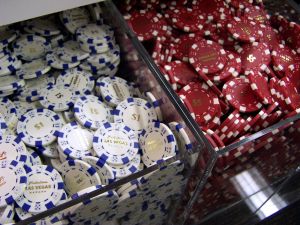Example 6-3 Section

Bowl A contains 2 red chips; bowl B contains two white chips, and bowl C contains 1 red chip and 1 white chip. A bowl is selected at random, and one chip is taken at random from that bowl. What is the probability of selecting a white chip?
Answer
Let \(A\) be the event that Bowl A is randomly selected; let \(B\) be the event that Bowl B is randomly selected; and let \(C\) be the event that Bowl C is randomly selected. Because there are three bowls that are equally likely to be selected, \(P(A)=P(B)=P(C)=\dfrac{1}{3}\). Let W be the event that a white chip is randomly selected. The probability of selecting a white chip from a bowl depends on the bowl from which the chip is selected:
- \(P(W|A)=0\)
- \(P(W|B)=1\)
- \(P(W|C)=\dfrac{1}{2}\)
Now, a white chip could be selected in one of three ways: (1) Bowl A could be selected, and then a white chip be selected from it; or (2) Bowl B could be selected, and then a white chip be selected from it; or (3) Bowl C could be selected, and then a white chip be selected from it. That is, the probability that a white chip is selected is:
\(P(W)=P[(W\cap A)\cup (W\cap B)\cup (W\cap C)]\)
Then, recognizing that the events \(W\cap A\), \(W\cap B\), and \(W\cap C\) are mutually exclusive, while simultaneously applying the Multiplication Rule, we have:
\(P(W)=P(W|A)P(A)+P(W|B)P(B)+P(W|C)P(C)\)
Now, we just need to substitute in the numbers that we know. That is:
\(P(W)=\left(0\times \dfrac{1}{3}\right)+\left(1\times \dfrac{1}{3}\right)+\left(\dfrac{1}{2}\times \dfrac{1}{3}\right)=0+\dfrac{1}{3}+\dfrac{1}{6}=\dfrac{1}{2}\)
We have determined that the probability that a white chip is selected is \(\dfrac{1}{2}\).
If the selected chip is white, what is the probability that the other chip in the bowl is red?
Answer
The only bowl that contains one white chip and one red chip is Bowl C. Therefore, we are interested in finding \(P(C|W)\). We will use the fact that \(P(W)=\frac{1}{2}\), as determined by our previous calculation. Here is how the calculation for this problem works:
\(P(C|W)=\dfrac{P(C\cap W)}{P(W)}=\dfrac{P(W|C)P(C)}{P(W)}=\dfrac{\dfrac{1}{2}\times \dfrac{1}{3}}{\dfrac{1}{2}}=\dfrac{1}{3}\)
The first equal sign comes, of course, from the definition of conditional probability. The second equal sign comes from the Multiplication Rule. And, the third equal sign comes from just substituting in the values that we know. We've determined that the probability that the other chip in the bowl is red given that the selected chip is white is \(\dfrac{1}{3}\).
Example 6-4 Section

Each bag in a large box contains 25 tulip bulbs. Three-fourths of the bags are of Type A containing bulbs for 5 red and 20 yellow tulips; one-fourth of the bags are of Type B contain bulbs for 15 red and 10 yellow tulips. A bag is selected at random and one bulb is planted. What is the probability that the bulb will produce a red tulip?
Answer
If \(A\) denotes the event that a Type A bag is selected, then, because 75% of the bags are of Type A, \(P(A)=0.75\). If \(B\) denotes the event that a Type B bag is selected, then, because 25% of the bags are of Type B, \(P(B)=0.25\). Let \(R\) denote the event that the selected bulb produces a red tulip. Then:
What is the probability that the bulb will produce a yellow tulip?
Answer
Let Y denote the event that the selected bulb produces a yellow tulip. Then:
If the tulip is red, what is the probability that a bag having 15 red and 10 yellow tulips was selected?